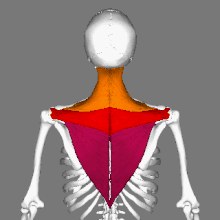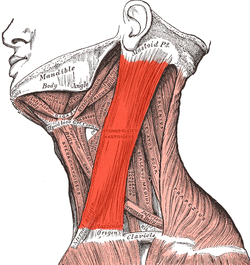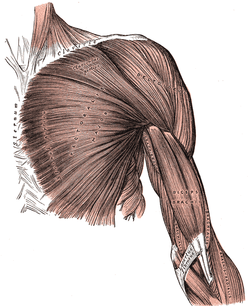Overview
If you want the best three stretches for upper back health, then start with these three in the video below. The affected muscles include upper Trapezius, Sternocleidomastoid and Pectoralis Major (and Minor). These three muscles, when tight, are the main cause of a forward head posture (FHP).
Disclaimer
Please consult your medical practitioner for advice before undertaking any of these exercises. This upper back health video does not constitute medical advice.
Upper Trapezius

The upper fibres (in orange above) run from the base of the skull, back of neck to the outside part of the collar bone or clavicle. It raises the shoulder blade (scapula) and extends the head backwards, often leading to headaches. Tension accumulates easily in this muscle due to stress during our activities of daily life. It is good practise to become aware of when you are elevating your shoulders.
When you notice that you are unconsciously bringing your shoulders to your ears, soften the trapezius and bring your top of shoulder down towards the floor. You may often see people strengthening this muscle by doing a shoulder shrug. However, I am more concerned with stretching out this chronically tight muscle.
Sternocleidomastoid

Sternocleidomastoid (SCOM) runs from the top of the breast bone or sternum and the medial collar bone (clavicle) to the mastoid process behind the ear. It flexes the head & neck and turns the head to the opposite direction. As the day wears on, we tend to get tired and slouch forward leaving the SCOM muscle in a shortened range.
At the same time, the back of the neck shifts into extension, effectively compressing the structures at the back of the neck. Done over a long period, this leads to a FHP, which can be tricky to undo, especially as we get older. So it’s a really important muscle to stretch frequently.
Pectoralis Major

While a shortened SCOM & upper Trapezius muscle cause a FHP, a contraction in the Pectoralis Major muscle pulls the shoulder forward leading to rounded shoulders. The Pectoralis Major runs from the collar bone (clavicle), the breastbone (sternum) and the costal cartilage over to the top of the humerus bone of the shoulder joint.
The Pectoralis Major performs flexion, internal rotation and adduction of the shoulder joint. It is involved in throwing and performing push ups. Since most activities that we do (e.g. typing, driving) are performed in front of us, this muscle is kept in a shortened range and becomes easily tight.





